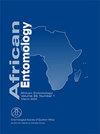Current and Future Biological Control Efforts Against Solanum mauritianum (Solanaceae) in South Africa
IF 1.2
4区 农林科学
Q3 ENTOMOLOGY
引用次数: 2
Abstract
Solanum mauritianum Scop. (Solanaceae), colloquially referred to as bugweed in South Africa, remains a widespread invasive tree of global significance. Although biological control (biocontrol) efforts were undertaken from 1984 -2003 in South Africa, the programme eventually only released two agents, the sap-sucking lace bug Gargaphia decoris Drake (Hemiptera: Tingidae) and flowerbud-feeding weevil Anthonomus santacruzi Hustache (Coleoptera: Curculionidae). To date, these agents have been relatively ineffective in controlling S. mauritianum, largely due to low establishment success due to climatic incompatibility in relation to the widespread distribution of S. mauritianum. This has prompted the revival of S. mauritianum biocontrol research in 2018, with the programme focused largely on sourcing additional agents from climatically suitable regions in the plant's native range in South America. Climate matching between cooler regions of South Africa and known S. mauritianum sites in South America identified Uruguay as a promising source of new agents. Field collections in Uruguay focused mainly on Anthonomus spp. but included stem-boring and shoot-galling weevils. Low incidence in the field and difficulties in culturing candidate species temporarily precluded research into stem-boring and shoot-galling candidates, but the rearing and assessment of the flowerbud-feeding weevil Anthonomus morticinus Clark (Coleoptera: Curculionidae) is ongoing. Host-specificity testing of A. morticinus has thus far confirmed a narrow host range, suggesting it has potential as a new agent.南非牡丹(茄科)生物防治的现状与未来
龙葵(茄科),在南非俗称为臭虫,仍然是一种具有全球意义的广泛入侵树。尽管从1984年到2003年在南非进行了生物防治工作,但该计划最终只释放了两种媒介,即吸汁的花蕾虫Gargaphia decoris Drake(半翅目:Tingidae)和食花蕾的象鼻虫Anthonomus santacruzi Hustache(鞘翅目:curculionae)。迄今为止,这些药剂在控制毛毛霉方面相对无效,主要是由于毛毛霉的广泛分布与气候不相容导致的建立成功率低。这促使毛里求斯海茅生物防治研究在2018年复苏,该项目主要侧重于从南美洲该植物原产范围内气候适宜的地区采购额外的药剂。在南非较冷地区和南美洲已知的s.m uritianum地点之间的气候匹配表明,乌拉圭是新药剂的有希望的来源。乌拉圭的野外采集主要集中在花象鼻虫属,但也包括茎蛀象鼻虫和刺茎象鼻虫。野外发病率低,候选种培养困难,暂时阻碍了对茎蛀和芽刺候选种的研究,但对采食花芽象鼻虫(鞘翅目:象鼻虫科)的饲养和评价正在进行中。到目前为止,对morticinus的宿主特异性测试已证实其宿主范围较窄,这表明它具有作为新病原体的潜力。
本文章由计算机程序翻译,如有差异,请以英文原文为准。
求助全文
约1分钟内获得全文
求助全文
来源期刊

African Entomology
生物-昆虫学
CiteScore
2.00
自引率
0.00%
发文量
17
审稿时长
6-12 weeks
期刊介绍:
African Entomology (ISSN 1021-3589 – print / 2224-8854 – online) replaced the old Journal of the Entomological Society of Southern Africa in 1993. A single volume consisting of two issues (March and September) is published annually. The journal is indexed in all major abstracting journals
African Entomology is a peer reviewed scientific journal that publishes original research articles and short communications on all aspects of entomology, with an emphasis on the advancement of entomology on the African continent.
 求助内容:
求助内容: 应助结果提醒方式:
应助结果提醒方式:


